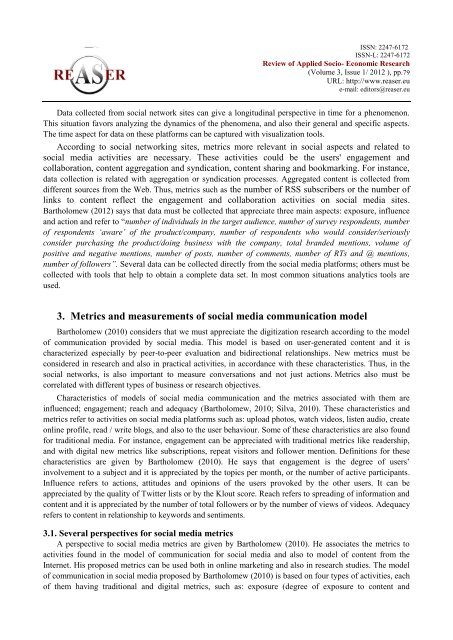Volume 3, ISSUE1/2012 - Review of Applied Socio-Economic ...
Volume 3, ISSUE1/2012 - Review of Applied Socio-Economic ...
Volume 3, ISSUE1/2012 - Review of Applied Socio-Economic ...
You also want an ePaper? Increase the reach of your titles
YUMPU automatically turns print PDFs into web optimized ePapers that Google loves.
ISSN: 2247-6172<br />
ISSN-L: 2247-6172<br />
<strong>Review</strong> <strong>of</strong> <strong>Applied</strong> <strong>Socio</strong>- <strong>Economic</strong> Research<br />
(<strong>Volume</strong> 3, Issue 1/ <strong>2012</strong> ), pp.79<br />
URL: http://www.reaser.eu<br />
e-mail: editors@reaser.eu<br />
Data collected from social network sites can give a longitudinal perspective in time for a phenomenon.<br />
This situation favors analyzing the dynamics <strong>of</strong> the phenomena, and also their general and specific aspects.<br />
The time aspect for data on these platforms can be captured with visualization tools.<br />
According to social networking sites, metrics more relevant in social aspects and related to<br />
social media activities are necessary. These activities could be the users' engagement and<br />
collaboration, content aggregation and syndication, content sharing and bookmarking. For instance,<br />
data collection is related with aggregation or syndication processes. Aggregated content is collected from<br />
different sources from the Web. Thus, metrics such as the number <strong>of</strong> RSS subscribers or the number <strong>of</strong><br />
links to content reflect the engagement and collaboration activities on social media sites.<br />
Bartholomew (<strong>2012</strong>) says that data must be collected that appreciate three main aspects: exposure, influence<br />
and action and refer to “number <strong>of</strong> individuals in the target audience, number <strong>of</strong> survey respondents, number<br />
<strong>of</strong> respondents ‘aware’ <strong>of</strong> the product/company, number <strong>of</strong> respondents who would consider/seriously<br />
consider purchasing the product/doing business with the company, total branded mentions, volume <strong>of</strong><br />
positive and negative mentions, number <strong>of</strong> posts, number <strong>of</strong> comments, number <strong>of</strong> RTs and @ mentions,<br />
number <strong>of</strong> followers”. Several data can be collected directly from the social media platforms; others must be<br />
collected with tools that help to obtain a complete data set. In most common situations analytics tools are<br />
used.<br />
3. Metrics and measurements <strong>of</strong> social media communication model<br />
Bartholomew (2010) considers that we must appreciate the digitization research according to the model<br />
<strong>of</strong> communication provided by social media. This model is based on user-generated content and it is<br />
characterized especially by peer-to-peer evaluation and bidirectional relationships. New metrics must be<br />
considered in research and also in practical activities, in accordance with these characteristics. Thus, in the<br />
social networks, is also important to measure conversations and not just actions. Metrics also must be<br />
correlated with different types <strong>of</strong> business or research objectives.<br />
Characteristics <strong>of</strong> models <strong>of</strong> social media communication and the metrics associated with them are<br />
influenced; engagement; reach and adequacy (Bartholomew, 2010; Silva, 2010). These characteristics and<br />
metrics refer to activities on social media platforms such as: upload photos, watch videos, listen audio, create<br />
online pr<strong>of</strong>ile, read / write blogs, and also to the user behaviour. Some <strong>of</strong> these characteristics are also found<br />
for traditional media. For instance, engagement can be appreciated with traditional metrics like readership,<br />
and with digital new metrics like subscriptions, repeat visitors and follower mention. Definitions for these<br />
characteristics are given by Bartholomew (2010). He says that engagement is the degree <strong>of</strong> users’<br />
involvement to a subject and it is appreciated by the topics per month, or the number <strong>of</strong> active participants.<br />
Influence refers to actions, attitudes and opinions <strong>of</strong> the users provoked by the other users. It can be<br />
appreciated by the quality <strong>of</strong> Twitter lists or by the Klout score. Reach refers to spreading <strong>of</strong> information and<br />
content and it is appreciated by the number <strong>of</strong> total followers or by the number <strong>of</strong> views <strong>of</strong> videos. Adequacy<br />
refers to content in relationship to keywords and sentiments.<br />
3.1. Several perspectives for social media metrics<br />
A perspective to social media metrics are given by Bartholomew (2010). He associates the metrics to<br />
activities found in the model <strong>of</strong> communication for social media and also to model <strong>of</strong> content from the<br />
Internet. His proposed metrics can be used both in online marketing and also in research studies. The model<br />
<strong>of</strong> communication in social media proposed by Bartholomew (2010) is based on four types <strong>of</strong> activities, each<br />
<strong>of</strong> them having traditional and digital metrics, such as: exposure (degree <strong>of</strong> exposure to content and








